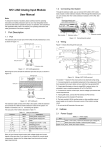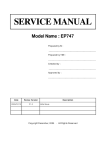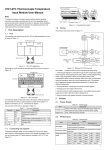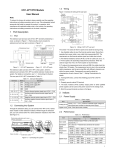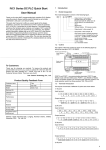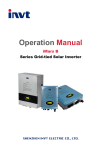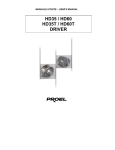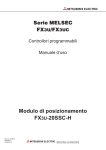Download IVC1-5AM Analog I/O Module User Manual
Transcript
IVC1-5AM Analog I/O Module Load User Manual ① ④ Thank you for using INVT Auto-control Technology Co. Ltd. programmable logic controller (PLC). Before using the IVC1 series PLC product, please carefully read this booklet so as to better understand it, fully use it, and ensure safety. VO+ ⑥ IO+ VIO - ② AGND ⑨ Voltage input ② ① 1 Port Description CHO AGND 390 K V4+ I4+ VI4FG 130 K AGND CH 4 250 130 K 390 K Current input 1.1 Port ② ① AGND 130 K AGND 130 K 390 K 24 V+ ⑦ CH 1 250 +5V DC /DC PGND ⑧ 24Vdc 10% 60mA The extension port and user port of IVC1-5AM are both protected by a cover, as shown in Figure 1-1. Removing the covers reveals the extension port and user port, as shown in Figure 1-2. 390 K V1+ I1+ ⑤ VI1FG ③ AGND converter 24V- -5V EC 10-5AM Figure 1-4 Wiring of IVC1-5AM user port The circled 1 ~ 9 stands for the six points to be observed during wiring: 1. It is recommended to use shielded twisted pair for the analog input and output. Route them separate from power cables or any cables that may generate EMI. Figure 1-1 IVC1-5AM appearance Figure 1-2 IVC1-5AM Ports The extension cable connects IVC1-5AM to the system, while the extension port connects IVC1-5AM to another extension module of the system. For details on connection, see 1.2 Connecting Into System. 3. If strong EMI exists, connect the FG and PG terminals together. 4. Each load of the PLC should be grounded separately. 5. If a channel is used for current input, short its voltage input terminal and current input terminal. The user port of IVC1-5AM is described in Table 1-1. Table 1-1 2. If the I/O signal has electric noise or voltage fluctuation, it is advisable to connect a smoothing capacitor (0.1µF~0.47µF/25V). User port description Terminal Name 1 24V+ Analog power supply 24V+ 6. Shorting the voltage output terminals or connecting current load to the voltage output terminals may damage IVC1-5AM. 2 24V- Analog power supply 24V- 7. Properly ground the module’s PG terminal. 3 FG Shileding ground 4 PG Protection ground 8. The basic module’s 24Vdc output power or any qualified external power supply can be used as the power source of the module’s analog circuit. 5, 8, 11, 14 V1+~V4+ CH1 ~CH4 voltage input 9. Do not use the NC terminal of the user port. 6, 9, 12, 15 I1+ ~ I4+ CH1 ~ CH4 current input 7, 10, 13, 16 VI1- ~ VI4- CH1 ~ CH4 signal input 17 · 18 VO+ Output channel voltage output 19 IO+ Output channel current output 20 VIO- Common GND of output channel Description 2 Indices NC Note: an input channel cannot receive both voltage signals and current signals at the same time. If you intend to use a channel for current signal measurement, short its voltage input terminal and current input terminal. 2.1 Power Supply Table 2-1 Item Power supply Description Analog circuit 24Vdc (-15%~20%), maximum allowable ripple voltage 5%, 90mA (from basic module or external power supply) Digital circuit 5Vdc 50mA (from basic module) 1.2 Connecting Into System Through the extension cable, you can connect IVC1-5AM to IVC1 series basic module or other extension modules. While through the extension port, you can 2.2 Performance Table 2-2 connect other IVC1 series extension modules to IVC1-5AM. See Figure 1-3. Item Voltage -10~10Vdc (input impedance 1MΩ) *Warning: this module can be damaged if the input voltage exceeds ±15Vdc Current -20~20mA (input impedance 250Ω) *Warning: this module can be damaged if the input current exceeds ±32mA Voltage -10~10Vdc (external load impedance ≥2kΩ) Current 0~20mA (external load impedance ≤520Ω) Analog input range Extens ion cable Index 15ms/channel (normal), 8ms/channel (high Conversion AD conversion speed) speed DA conversion 2ms/channel (max.) Rem oving extension port cov er before connection Basic module Performance Extension m odule 1.3 Wiring Analog output range The wiring of user port is shown in Figure 1-4. Digital output Default: -2000 ~ 2000 Setting range: -10000 ~ 10000 Digital input Default: -2000 ~ 2000 Setting range: -10000 ~ 10000 Figure 1-3 Connecting IVC1-5AM to the basic module Resolution Item Table 2-4 Index Voltage input 5mV Current input 10µA BFM#300 status information Bit status of BFM#300 ON (1) OFF (0) b0: error b1 or b2 is ON, AD/DA conversion of No error all channels stopped b1: deviation, gain error Channel characteristics setting error in BFM Deviation/gain data normal b2: power supply failure 24Vdc power supply failed Power supply normal b3: hardware fault AD/DA converter or other hardware faulty Hardware normal 2.3 Buffer Memory b10: digital range error IVC1-5AM exchanges data with the basic module through Buffer Memory (BFM). After IVC1-5AM is set through the host software, the basic module will write data into IVC1-5AM BFM to set the state of IVC1-5AM and display the data from IVC1-5AM on the host software interface. See Figure 4-1 and Figure 4-1. 1. Digital output after AD conversion Digital outside the range of -2048 ~ +2047; 2. input/output value Digital input for DA conversion outside normal specified range b11: average sampling times setting error Setting outside normal range (in this case, the default 8 will be used) Voltage output 5mV Current output 10µA Accuracy Analog input ±1% of full range Analog output ±1% of full range Between analog circuit and digital circuit: photocoupler. Between analog circuit and input 24Vdc power: internal isolation. Between analog channels: none Isolation Table 2-3 describes the contents of IVC1-5AM BFM. Table 2-3 BFM Setting within normal range: 1~4096 4. BFM#600: input mode selection, used to set the input modes of CH1 ~ CH4. See Figure 2-1 for their correspondence. BFM Contents Description and default Contents # 600 0x × × 4 3 × 2 Property #000 CHO channel data Output channel #100 Average value of CH1 Input channel R #101 Average value of CH2 Input channel R × 1 Input mode for CH1 Input mode for CH2 RW Input mode for CH3 Input mode for CH4 Figure 2-1 Mode setting element vs. channel #102 Average value of CH3 Input channel R #103 Average value of CH4 Input channel R #200 Current value of CH1 Input channel R #201 Current value of CH2 Input channel R #202 Current value of CH3 Input channel R #203 Current value of CH4 Input channel R #300 Module error state word #600 Input channel model word 0x0000 RW #650 output channel model word 0x0000 RW For example, if #600 is written as ‘0x0103’, the setting will be like this: #700 Average sampling times of CH 1 8 RW #701 Average sampling times of CH2 8 RW #702 Average sampling times of CH3 8 RW #703 Average sampling times of CH4 8 RW #900 CHO-D0 0 (output mode 0) RW #901 CHO-A0 0 (output mode 0) #902 CHO-D1 2000 (output mode 0) RW #903 CHO-A1 10000 (output mode 0) R #904 CH1-D0 0 (input mode 0) RW #905 CH1-A0 0 (input mode 0) R #906 CH1-D1 2000 (input mode 0) RW #907 CH1-A1 10000 (input mode 0) R #908 CH2-D0 0 (input mode 0) #909 CH2-A0 0 (input mode 0) #910 CH2-D1 2000 (input mode 0) #911 CH2-A1 10000 (input mode 0) #912 CH3-D0 0 (input mode 0) RW #913 CH3-A0 0 (input mode 0) R #914 CH3-D1 2000 (input mode 0) #915 CH3-A1 10000 (input mode 0) #916 CH4-D0 0 (input mode 0) #917 CH4-A0 0 (input mode 0) #918 CH4-D1 2000 (input mode 0) #919 CH4-A1 10000 (input mode 0) The exact meaning of the X in the channel mode is shown in Table 2-5. Table 2-5 Value of X 0 R R RW Information -10V ~ +10V voltage input mode 1 -5V~+5V voltage input or -20mA~+20mA current input mode 3 Channel closed Input channel 1 closed; Input channel 3 mode: -5V ~ +5V or -20mA ~ 20mA (note the wiring difference in voltage and current, see 1.3 wiring); Input CH2, and CH4 mode: -10V ~ +10V. 5. BFM#650: output mode selection, controlled by the X1 in the 4-bit hexadecimal number 0x×4× 3×2×1 . The meaning of X is as follows: Table 2-6 Bit Value X1 X2 ~ X4 Meaning of X in output mode Information 0 -10V ~ +10V voltage output mode 1 0 ~ 20mA current output mode 2 4 ~ 20mA current output mode Reserved R RW R RW R RW R RW R #2000 AD conversion speed switchover 0 (15ms/CH) RW #2100 Channel reset 0x0000 RW #4094 Module software version 0x1000 R #4095 Module ID 0x3141 R Explanation: 1. CH1 stands for channel 1; CH2, channel 2; CH3, channel 3, and so on. 2. Property explanation: R means read only. An R element cannot be written. RW means read and write. Reading from a non-existent element will get 0. 3. Status information of BFM#300 is shown in Table 2-4. Meaning of X in input mode 6. BFM#700 ~ BFM#703: average sampling times setting; setting range: 1~4096. Default: 8 (normal speed); choose 1 if high speed is needed. 7. BFM#900 ~ 919: channel gain and deviation settings, which are set using two-point method. D0 and D1 represent channel digital output, A0 and A1 represent actual channel input. A0 and A1 are in mV or µA, and each channel occupies 4 words. To simplify the setting operation without affecting functions, A0 and A1 are respectively fixed to 0 and the max value. Users cannot change them. Note: If the channel input is current signal (-20mA~20mA), the present channel mode should be set to 1. Because the channel’s internal measurement is based on voltage signal, current signals should be converted into voltage signals (-5V~5V) by the 250Ω resistor at the current input terminal of the channel. The A1 in the channel’s characteristics setting is still in mV unit, i.e., 5000mV (20mA × 250Ω = 5000mV). 8. BFM#2000: AD conversion speed setting. 0: 15ms/channel (normal speed); 1: 8ms/channel (high speed). Setting BFM#2000 will restore BFM#1 ~ #2 to the default, which should be noted in programming. If necessary, you can reset BFM#700 ~ #703 after changing the conversion speed. 9. BFM#4094: module software version, displayed automatically as Module Version in IVC1-5AM Configuration dialogue box of the host software, as shown in Figure 4-2. 11. BFM#4095: module ID. ID of IVC1-5AM is 0x3141. The user program in PLC can use this ID to identify the module before transceiving data. be defined by just two points: P0 (A0, D0) and P1 (A1, D1), where D0 is the channel’s digital input corresponding to analog output A0, and D1 is the channel’s digital input corresponding to analog output A1. 3 Characteristic Setting A ( mV ) P1 A1 3.1 Setting Analog Input Channel Characteristics The input channel characteristic of IVC1-5AM is the linear relationship between the channel’s analog input A and digital output D. It can be set by the user. Each channel can be considered as the model shown in Figure 3-1. As it is of linear characteristic, the channel characteristic can be defined by just two points: P0 (A0, D0) and P1 (A1, D1), where D0 is the channel’s digital output corresponding to analog input A0, and D1 is the channel’s digital output corresponding to analog input A1. P1 D Digital output Channel D0 P0 A (mV) A1 A0 Channel model A Channel Digital output P0 D0 Analog input D1 D Channel model Channel characteristic setting Figure 3-4 IVC1-5AM output channel characteristic To simplify the operation process without affecting functions, A0 and A1 are respectively fixed to 0 and the maximum value in the present mode. That is to say, in Figure 3-4, A0 is 0 and A1 is the maximum analog output in the present mode. A0 and A1 will change according to the mode when BFM#600 is changed. Users cannot change their values. D D1 A Analog input A0 D If you set the channel mode (BFM#600) without changing D0 and D1 of the corresponding channel, the channel characteristic vs. mode should be as shown in Figure 3-5. The A in Figure 3-5 is default. Channel characteristic setting Figure 3-1 IVC1-5AM input channel characteristic To simplify the operation process without affecting functions, A0 and A1 are respectively fixed to 0 and the maximum value in the present mode. That is to say, in Figure 3-1, A0 is 0 and A1 is the maximum analog input in the present mode. A0 and A1 will change according to the mode when BFM#601 is changed. Users cannot change their values. If you just set the channel mode (BFM#601) without changing the D0 and D1 of the corresponding channel, the channel characteristic vs. mode should be as shown in Figure 3-2. The A in Figure 3-2 is default. D 2000 D 2000 A ( mV) 0 - 10000 10000 A ( mV ) - 5000 0 5000 A ( mV ) A (mV) 10000 5000 D 0 - 2000 2000 D -2000 0 - 10000 - 5000 B. Mode 1 A. Mode 0 (default) Figure 3-5 Default output channel characteristics in various modes You can change the channel characteristic by changing D0 and D1. The setting range of D0 and D1 is -10,000 ~ 10,000. If the setting is outside this range, IVC1-5AM will not accept it, but maintain the original valid setting. Figure 3-6 provides for your reference an example of changing channel characteristics. A ( mV) A (mV) - 2000 5000 10000 - 2000 P1 P1 A. Mode 0 (default) B. Mode 1 D 0 Figure 3-2 Default input channel characteristics in various modes You can change the channel characteristic by changing D0 and D1. The setting range of D0 and D1 is -10,000 ~ 10,000. If the setting is outside this range, IVC1-5AM will not accept it, but maintain the original valid setting. Figure 3-3 provides for your reference an example of changing channel characteristics. D 10000 D 2000 P1 -10000 P1 A ( mV) 0 P0 2000 10000 A( mV) 0 - 5000 - 500 1000 P0 -10000 P0 10000 D 0 -3000 -500 1000 P0 2000 - 10000 - 5000 A Mode 0, D0 = 0, D1 = 10,000 Digital input 10,000 outputs 10V Digital input 0 outputs 0V B Mode 0, D0 = -500, D1 = 2000 Digital input 2000 outputs 5V (or 20mA) Digital input 0 outputs 1V Digital input -10,000 outputs -10V Digital input -10,000 outputs -5V Figure 3-6 Changing output channel characteristics 5000 4 Application Example 4.1 Basic Application - 10000 - 3000 A Mode 0, D0 = 0, D1 = 10,000 Analog input 10V outputs 10,000 Analog input 0V outputs 0 B Mode 1, D0 = -500, D1 = 2000 Analog input 5V (or 20mA) outputs 2000 Analog input 1V (or 4mA) outputs 0 Analog input -5V (or -20mA) outputs Analog input -10V outputs -10,000 -3000 Figure 3-3 Changing input channel characteristics 3.2 Setting Analog Output Channel Characteristics The analog output channel characteristic of IVC1-5AM is the linear relationship between the channel’s analog output A and digital input D. It can be set by the user. Each channel can be considered as the model shown in Figure 3-4. Because it is of linear characteristic, the channel characteristic can Example: The IVC1-5AM module address is 1 (for the addressing of extension modules, see IVC Series PLC User Manual). Use its channels 1, 2, 3 and 4 for voltage signal input (-10V~10V), set the average sampling times to 8, and use data registers D1, D2, D3 and D4 to receive the average value; set output channel to mode 0 to output 10V voltage signal, and use D5 element. Set extension module type as shown in Figure 4-1, and set actual parameters of extension module. Figure 4-2 shows the setting of input channel 1 and output channel 1. Set the other three input channels respectively in the same way. Flash slowly or OFF: check the data in BFM#300. Notice 1. The warranty range is confined to the PLC only. 2. Warranty period is 18 months, within which period INVT Auto-control Technology Co. Ltd. conducts free maintenance and repairing to the PLC that has any fault or damage under the normal operation conditions. 3. The start time of warranty period is the delivery date of the product, of which the product SN is the sole basis of judgment. PLC without a product SN shall be regarded as out of warranty. 4. Even within 18 months, maintenance will also be charged in the following situations: Figure 4-1 Damages incurred to the PLC due to mis-operations, which are not in compliance with the User Manual; Damages incurred to the PLC due to fire, flood, abnormal voltage, etc; Damages incurred to the PLC due to the improper use of PLC Setting special module type functions. 5. The service fee will be charged according to the actual costs. If there is any contract, the contract prevails. 6. Please keep this paper and show this paper to the maintenance unit when the product needs to be repaired. 7. If you have any question, please contact the distributor or our company directly. Shenzhen INVT Auto-control Technology Co., Ltd. Address: Gaofa Industry Park, Longjing ,Nanshan District 518055, Shenzhen China Homepage: www.invt.com.cn Figure 4-2 Setting special module parameters To validate the parameter setting, you still need to compile and download the parameters. You can set and query D elements through the interface or by using the MOV instruction in user program. MOV D5 2000 is a user program that makes the output channel output 10V. For further details, see IVC Series PLC Programming Manual. 5 Operation Inspection 5.1 Routine Inspection 1. Check that the wiring of analog input meets the requirements (see 1.3 wiring). 2. Check that the extension cable of IVC1-5AM is properly inserted in the extension port. 3. Check that the 5V and 24V power supplies are not overloaded. Note: The digital circuit of IVC1-5AM is powered by the basic module through the extension cable. 4. Check the application and make sure the operation method and parameter range are correct. 5. Set the IVC1 basic module to RUN state. 5.2 Fault Inspection In case of abnormality, check the following items: ● the status of the POWER indicator ON: the extension cable is properly connected; OFF: check the extension cable connection and the basic module. ● the analog wiring ● the status of the 24V indicator ON: 24Vdc power supply normal; OFF: 24Vdc power supply possibly faulty, or IVC1-5AM is faulty. ● the status of the RUN indicator Flash quickly: IVC1-5AM in normal operation; Version V1.0 Revision date September 28, 2011 All rights reserved. The contents in this document are subject to change without notice.




